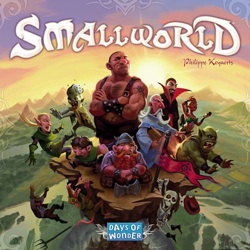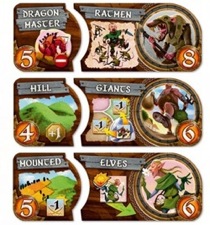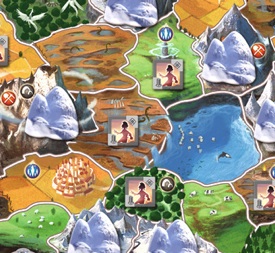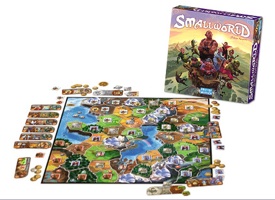
|
About OgreCave and its staff
|

|
by Lee Valentine
This game is featured in the OgreCave Christmas Gift Guide 2009 Small World ("SW" hereinafter) is the newest boardgame release from Days of Wonder ("DoW"). It is one part wargame, one part resource management game, and a dash of CCG-style mechanics thrown in, all with a fantasy-based world domination theme pasted on top. The goal is to amass victory points by controlling regions on a fantasy world map. The game is played for eight to ten turns, depending on the number of players. SW reinvents a 1999 game (Vinci) by the same designer, Philippe Keyaerts, but it does so in a way which simplifies the game, adds a bit more chaos, controls game length, and adds enormously to the production value.
Overview
In addition to the 14 race tiles ("banners"), there are 20 Special Power or descriptor tiles ("badges"). These descriptors include traits like "Hill", "Spirit", "Berserk", "Pillaging", and "Seafaring". The descriptors are designed to be placed next to the race banners, thus creating 280 different possible race and power combinations, including amusing ones like Hill Tritons, Mounted Giants (those poor horses!), and Pillaging Halflings. Like the racial banners, the Special Power badges feature graphics to remind players of a distinct power or powers the individual Special Power badge grants to the race it is associated with.
Game Rules Players do not immediately each start the game with one race as you might expect. Instead, at the start of each player's first turn, he chooses a race/power combo from those visible on the table. If he chooses the first pair (those at the top of the column), it is free to him. If, however, he chooses one of the other combos, he must put one of the five victory point tokens he starts the game with on top of each race/power combo in the column above the one he selects. The column gap (if any) is closed up, and a new race/power combination is dealt off the top of the Race and Special Power "decks" to the fifth position in the column. In this way, six new race/power combos are usually available to players throughout the game. The victory points placed on passed-over combos during this selection process continue to amass until they are eventually awarded to someone who actually chooses to play a less desirable combination. Upon taking a race/power combo you are allotted a certain number of Race tiles to use as unit tokens for the remainder of the game. How many you get is determined by the Race and Special Power banners you chose. At the corner of each banner is a number, and the sum of the Race and Special Power numbers tell you how many starting race tokens you get to conquer the Small World. For example Merchant (2) Dwarves (3) get five tokens, while Flying (5) Ratmen (8) get 13 starting tokens. Races have a total maximum number of tokens that vary by race, based on the number of tokens that Days of Wonder included in the box. So, it is possible that a certain race/power combo may allot you with all the dwarf tokens that came in the box, while another one may leave you with some leftovers. You do not have ready access to any leftover race tokens during the game unless a Special Power or Racial Power tells you otherwise. This starting token allotment is often all you have for the whole game, and your race will probably start to die off quickly. In this way, SW is not like Risk or other area control games where you have a deep bin of generic tokens that you continue to amass over the course of the game. After you take your starting race and their tokens, you immediately start conquering regions on the board. Regions include forests, hills, swamps, farmland, mountains, seas, or lakes, with the water areas generally being off-limits to any race without the "Seafaring" Special Power. Mountains start the game with special mountain tokens in them, and also at the start of the game, some regions start out with Lost Tribe tokens in them. Lost Tribes are the cannon fodder of SW, representing an ancient race in decline, who can no longer mount successful attacks on anyone; they merely exist to defend their ancient lands. For the most part, conquests are non-random. You count up the number of cardboard markers and tokens of all kinds (including mountains, race or Lost Tribe tokens, and structure markers that some power combos let you construct). Then you add two to that sum. That tells you how many of your own race tokens you have to commit to take over the region. For example if there is a mountain marker (1) and three elf tokens (3), you add 2 to that, and you will need 6 orc tokens (or whatever race you're playing) to conquer the region.
At the end of your turn of conquests you can redeploy your forces, moving your race tokens from one area you control to another, provided that you leave at least one race token in each region you control. At the start of your next turn, you gather as many of your race tokens as you want to from the board (even if that means you abandon previously conquered regions) to make fresh conquests. Over time a race can become effectively unplayable, or at least undesirable, once too many of their starting number have been removed from play. Thankfully, the game has an innovative mechanic that lets you retire an older race to acquire a new one. This is called putting a race "Into Decline". Instead of conquering on a turn, you declare that you are going Into Decline. You flip over your race tokens on the board to their back sides, which are grayed out pictures of your race instead of full color. Then you get to keep only one token in each region that you control, with all the extras being retired to the game box. On your next turn, you pick a new race and you start making conquests with your new race instead of your In Decline race. Your In Decline race does not aid you in making these new conquests, and you need not make your new race's conquests adjacent to your In Decline race. Typically your race In Decline can never attack again and often loses all of its special powers. You can go Into Decline multiple times during the game, but you only get to keep two total races: one Active one and one In Decline. As you put a new race Into Decline, your old In Decline race is stripped from the board. You win the game by amassing Victory coins. At the end of your turn, you score one victory point coin for each region you control with your Active and In Decline races, plus any point modifiers that may be associated with your race/power combo. All your victory points are kept secret throughout the game, leaving doubts in the minds of anyone without a perfect memory as to who is exactly in the lead at any one time. This allows for blame shifting and diplomacy over the course of the game to get people to team up on a perceived scoring leader even if he isn't the actual front runner. There is one minor element of luck in the game. A single die roll is allowed once on your last conquest of the turn, which makes it easier to take over a region you otherwise have insufficient forces to conquer. With the exception of certain Special Powers, this roll happens at most once per player turn. 50% of the die's faces are blank (meaning it offers no help half the time), but the other 50% of the time the die roll reduces the number of Race tokens needed to make a conquest (down to a minimum of one Race token that must be used to enter the conquered Region). This can occasionally help to unseat an opponent from a key territory. Since the die roll grants you no extra actual troops to hold on to the newly conquered Region, using the die too often during the game will tend to spread your troops a bit thin, making you vulnerable to counter-attack. Thus the die helps to make occasional modifications to control over the map, but it does not provide a means to make sweeping changes in the game. This keeps the focus of the game squarely on player skill, while periodically injecting a thrilling Vegas-style moment of play. The real guts of the game are the Racial Powers and Special Powers. Winning or losing often comes down to determining which combo is right for the current situation, and more importantly, realizing that before everyone else does. The race/power combos remind me very strongly of card combinations that are commonly found in most CCGs. Some powers are simple like the "Forest" badge which gives +1 Victory coin for each forest region you control. Other powers are more complex - like the "Sorcerers" race, which allows you to convert members of your enemy's race into Sorcerers, with a paragraph of restrictions and requirements surrounding this process.
Multi-Player Play While DoW advertises a 40-80 minute play time, our first four-player game lasted an estimated 2 hours and 15 minutes. We could have cut this play time down a fair bit with more experience, and the game would have flown by in two-player play. Still, the power combos in the game can add a bit of analysis paralysis and research time for players who haven't memorized all the powers in the rulebook. Nevertheless, I believe that experienced players may be able to play within the estimated time range.
Packaging & Components
The art on this product is really top notch. Artist Miguel Coimbra created a wide variety of clever images, all with a very fanciful and occasionally silly bent. There is a dwarf on the cover blowing a snot bubble from his nose, and skeletons wear cowboy hats and boots. The map looks more like art and less like a standard game board because regions aren't always carbon copies of each other. Some mountains have caves in the side, while another is clearly a dormant volcano. The color palette is vibrant and wonderful on the faces of the counters. My only complaint about the art is that the backs of the race tokens showing their In Decline side are so desaturated that you have to study the board occasionally to differentiate one Declined race from another. There are a variety of large play aids that come with SW. These are like some of the graphics on the Racial banners and Power badges, in that they are nice mnemonic aids most of the time. Sometimes, however, they were just plain misleading. For example, the play aid merely says that Ghouls keep all their tokens on the board when they go Into Decline, and this leaves out the huge piece of information that the Ghouls can continue to attack while they are In Decline. For my gaming group, I developed little power cards that combined the info from the FAQ and the rulebook, as I felt the powers quick reference wasn't a good replacement for memorizing or referencing about four pages of the rulebook. This, again, made it feel like a CCG, where I typically am expected to memorize a fair bit of text and recall it based primarily on a card name and some graphics. Thankfully, there are only 20 Special Powers badges and 14 Racial banners, so this is doable, particularly since many abilities are very simple. While the counters and boards included in the game are absolutely great, I downgraded the components grade for inadequate player aids. Even the turn reference leaves out the fact that you still score victory points on turns where you go Into Decline, a major detail.
Rules Complexity & Clarity My single strongest complaint with the game comes from the clarity of the special powers in the rulebook and on the player aids that come with the game. Days of Wonder specializes in making beautiful, simple rulebooks. Unfortunately, most Days of Wonder rulebooks that I own leave out some key information on how to play. Small World is no exception, and this results in a Frequently Asked Questions (FAQ) file on the internet which DoW doesn't even link to from their product page. Most commonly asked questions are immediately obvious from perusing the rulebook, but sometimes the answers just aren't in the rules, or what's there is misleading. The FAQ for the game is available on the Days of Wonder message boards, and while it answers some questions, it will raise a few eyebrows with some potentially counter-intuitive rulings. Without the FAQ, you'll probably have to house rule some things around the edges of the game.
Conclusions What tells me this game is a keeper is that I had fun sitting around thinking about the power combos for hours. SW comes with one blank Special Power badge and one blank Racial Banner, to let you come up with your own creations. At the time of this writing, DoW even has a contest to design your own powers to be included in an upcoming expansion. Unlike a CCG, since these elements sit on the table and don't really have to be shuffled in the same way that a playing card does, this game really encourages homebrew creativity for the artistically savvy among us. Playing Small World makes me think about it for days after, like watching a good action movie. While it doesn't have the highs and lows I have come to expect from other war games, it also doesn't have the frustration of being in fourth place in Risk and wishing someone would put you out of your misery. Regardless of the actual game length, it feels pretty fast-paced most of the time. It has the vibe of a light, chaotic game, but it is clearly possible to do better by mapping out a flexible strategy and taking good advantage of the race/power combos that best fit the situation. I think Small World is among the most memorable and unique war games I have played. I am not a big fan of most war games, but I am eager to play it again, and I strongly recommend it.
For Retailers I think that Small World's resource management and CCG-like elements will give it a far broader appeal than most traditional wargames. The core rules of play can be picked up fairly quickly by most experienced gamers. That, combined with some unique mechanics and fantastic production values, will make the game a gem to demo if you have the spare table space for it. Even leaving the game setup in a display will generate instant sales. Because the box cover is eye catching and features a variety of delightfully cartoonish fantasy characters, it will advertise itself when displayed face out to the consumer. As I mentioned, Days of Wonder made the brilliant decision to launch the game with a do-it-yourself power and race contest. The prize is a free trip to the Essen gaming event in Europe. This will keep alpha gamers playtesting their inventions for weeks to come, and they will bring their friends on board. Advertise this contest in your store if you have open gaming space, and your customers will demo it for you. Lee's Ratings
Overall: A- (potentially a B+ or B for rules lawyers and gamers with analysis paralysis) Links
|
||||
 Small World
Small World The 14 races include common fantasy tropes like dwarves and elves, but
also include more rarified races like tritons and ghouls. Each race has
small square tiles to be placed on the board as units, and each also
comes with a much larger tile that includes a graphical mnemonic aid for
that race's particular features and game-altering powers.
The 14 races include common fantasy tropes like dwarves and elves, but
also include more rarified races like tritons and ghouls. Each race has
small square tiles to be placed on the board as units, and each also
comes with a much larger tile that includes a graphical mnemonic aid for
that race's particular features and game-altering powers.
 When a region is conquered, the committed forces move in, and all the
old race tokens or any Lost Tribe tokens on that region are removed from
the board. Lost Tribe tokens are just returned to the box, but if your
opponent had his race tokens in that region, only one is returned to the
box and destroyed, while the rest are returned to your opponent at the
end of the current player's turn for redeployment to other regions he
controls. In this way, race tokens are constantly whittled away with
the remainder being amassed elsewhere on the board.
When a region is conquered, the committed forces move in, and all the
old race tokens or any Lost Tribe tokens on that region are removed from
the board. Lost Tribe tokens are just returned to the box, but if your
opponent had his race tokens in that region, only one is returned to the
box and destroyed, while the rest are returned to your opponent at the
end of the current player's turn for redeployment to other regions he
controls. In this way, race tokens are constantly whittled away with
the remainder being amassed elsewhere on the board.
 The only downsides to the packaging are with the race token tray. It is
designed to store the tokens on their sides rather than face up, and
there are no side labels included for the tray. Without referring to a
chart or peeking carefully, it's hard to know which race is which once
they are in the tray. Another hassle during play is that once you start
returning tokens to the tray they sometimes fall flat instead of
standing upright, occasionally forcing you to pry them out of tight
wells with your fingernails or a toothpick. Those hassles are
non-trivial, but I gave the packaging high marks because each game in my
collection spends much more time being stored than it does being played,
and I think this packaging is a cut above most in the industry.
The only downsides to the packaging are with the race token tray. It is
designed to store the tokens on their sides rather than face up, and
there are no side labels included for the tray. Without referring to a
chart or peeking carefully, it's hard to know which race is which once
they are in the tray. Another hassle during play is that once you start
returning tokens to the tray they sometimes fall flat instead of
standing upright, occasionally forcing you to pry them out of tight
wells with your fingernails or a toothpick. Those hassles are
non-trivial, but I gave the packaging high marks because each game in my
collection spends much more time being stored than it does being played,
and I think this packaging is a cut above most in the industry.